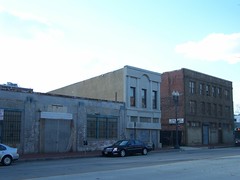Concentration and connection are key concepts for urban revitalization
 Across from the Washington Convention Center on 9th Street NW.
Across from the Washington Convention Center on 9th Street NW.Suburbs have the bad planning practice of spreading out through the creation and repetition of low concentration sprawl.
There is a line in one of the detective novels by Sara Paretsky, where V.I. Warshawski, describing a drive in Chicago's suburbs, where she says "The third time I passed a Border's* and a Bed, Bath and Beyond, I thought I was driving in circles." (* It might have been Barnes & Noble.)
If you believe in the Reilly Law of Retail Gravitation as I do then you know the "secret" to success in urban revitalization is having "more better offerings." It's not rocket science. The key is having more and better (and unique) stores, with a greater variety of offerings. It's what's called agglomeration in economics, or critical mass (usually in sociology and probably in the hard sciences).
The problem in the city(ies) is that once-suburbanites live here, with their sprawl planning and development paradigm. I wrote about this extensively in today's comment on historic preservation. That paradigm is all about separation.
But in the city, the key is transportation efficiency that allows for non-car mobility, and efficiency and quality in the offer. So it makes sense to improve and intensify development in our already commercial places (places that for the most part, have been disinvested in over the recent decades, rather than improved), rather than keep expanding and developing in a polycentric manner.
Remember about 10 days ago when I wrote some comments in response to expressed desires to make over the Florida Market as a power center? It's the same point.
Why should we have a sputtering H Street, a sputtering Hechinger Mall, and a redeveloped Florida Market as a big box extravaganza, when we could have a great H Street and a great Hechinger Mall, because there is the physical capacity to add these kinds of retail options, selectively, in places along the corridor (such as the north and south side of the 600 block, and in redeveloped sites on the 800 and 900 blocks south side (H Street Connection) and the 1200 block (Autozone) not to mention the Hechinger Mall area which is parking centric. (We can make great again the Florida Market, but around its extant assets--food and food distribution.)
This comes up in another context because there are two articles about college town-gown redevelopment issues. In the New York Times, we have "UConn Decides to Build Its Own College Town," while in the Post there is an article about the inexorable expansion of George Mason University, in "As GMU Grows, So Do Neighbors' Worries."
The Times article discusses two best practices college-town reconnection-revitalization efforts in Columbus, Ohio and Philadelphia (both of which I have discussed before). From the article:
In Columbus, Ohio, the City Council acknowledged that in 2002 when it adopted “A Plan for High Street: Creating a 21st-Century Main Street,” which includes a $130 million mixed-use development for the two-mile stretch of the street that runs past Ohio State University. At the University of Pennsylvania in Philadelphia, university officials announced plans in June to demolish a section of the north side of a main artery, Walnut Street, and add a $75 million development of midrise apartments and retail space.
Now, I know that universities can over-expand and take over adjacent neighborhoods (cf. George Washington University). But there is economic capacity amongst college students that can be captured to assist and strengthen retail in local commercial districts as well. This is why I keep suggesting that Catholic University's student bookstore be moved to the nearby 12th Street NE commercial district. This would strengthen and expand the offerings on the corridor, by pairing multiple consumer market segments, and provide more reasons for CUA students to look east instead of west, when seeking out retail and other options. Etc.
The point about agglomeration needs to be further discussed in two other instances with regard to development in DC, and in urban revitalization more generally.
First, as William Jordan of Columbia Heights pointed out a month or two ago (and I wrote about it then), WMATA's effort to bring retail to at least certain of their stations is misdirected. That resources (not WMATA's) need to be directed and focused on making the extant on-the-street commercial space more successful.
Second, when big projects come along, a significant amount of money needs to be directed towards the rehabilitation and use of commercial space in the area. 9th Street NW around the Convention Center is a perfect example. It's awful, albeit improving. No patron of the Convention Center in their right mind would leave the Center to explore 9th Street. Had time, money, and creativity been invested in improving that street long before the Convention Center opened, there could have been mutually reinforcing links between the two. Instead, people go into the Convention Center and return to wherever they come from, without spending much time or money in the adjacent area.
I don't know if it's possible to make Convention Centers work for local commercial districts (it's not like the area around the Javits Center in Manhattan is anything special...), but if so, you've got to deal with the broader environment around the locale, and have it "fixed and ready" before the place opens, not many years later.
Focus on improving what we have, and intensifying use in these extant commercial corridors, which are usually better served by transit anyway, rather than continually focusing on expanding development to new places.
Index Keywords: urban-design-placemaking



0 Comments:
Post a Comment
<< Home